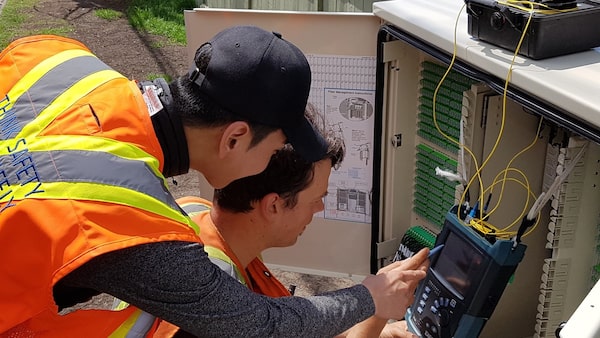
The role of telecommunications-systems technicians has evolved to include more customer-service responsibilities.British Columbia Institute of Technology/Handout
Job: Telecommunications-systems technician
The role: Telecommunications-systems technicians are responsible for the setup, maintenance, troubleshooting and testing of telecommunications equipment, such as telephone, voiceover IP (VOIP), radio and internet technologies.
“It could be something as minor as hooking up somebody’s phone because it got disconnected, or restoring a microwave link that connects a remote community to their radio system or fixing a broken fibre-optics cable that controls the communications systems for ambulance dispatch services,” said Alex Wai, the chief instructor of the telecommunications-systems-technician program at the British Columbia Institute of Technology.
Telecommunications-systems technicians are in high demand among telecommunications providers, but are also employed by providers of office-communication equipment, marine-communications systems and emergency services.
Mr. Wai adds that the role primarily comprises fieldwork, though there is some paperwork required. Furthermore, while the role was once entirely focused on the installation, testing and maintenance of communications technologies, it has evolved to include more customer-service responsibilities.
“People will be expecting a technician to come in, meet the customer, find out what problems they’re having and work to either install the equipment, test the equipment, troubleshoot if there’s a problem, and try to provide the best form of resolution to the problems,” he said.
Salary: According to Mr. Wai, the starting salary for telecommunications-systems technicians typically ranges from $19 to $28 an hour, averaging roughly $23 or $24, depending on the size of the company and type of operation. “Federal agencies generally pay better than small, private companies, so that’s why there’s such a broad range,” he said.
Mr. Wai adds that mid-career professionals can expect to earn between $40,000 and $50,000 a year, with more senior technicians earning anywhere from $65,000 to $80,000 a year.
“Northern territories, such as the Yukon, Northern B.C. or the oil patch, they tend to have a harder time finding people, so they’re willing to pay more to get people up there,” he said. “The bigger, unionized companies tend to have a better pay scale than the smaller private companies. However, for a technician looking for more of a challenge, the smaller companies will let you do more.”
According to Neuvoo, a Canadian job-listing aggregate website, the average salary of a telecommunications-systems technician in Canada is $60,200.
Education: While there are no firm educational requirements, those who enter the field without any relevant training are typically required to complete some form of on-the-job training, and often have more limited career prospects. A majority, though, complete a two-year college-level technician or technologist program.
“There’s a great deal more mathematics and knowledge required to graduate from a technologists program; it’s a lot more academics,” Mr. Wai said, adding that the technician programs are instead more focused on hands-on training.
Job prospects: The demand for telecommunications-systems technicians in Canada is high, and only expected to grow with the introduction of new telecommunications networks.
“The next generation of cellular-phone systems, the 5G systems, when they’re rolled out they will require a significant amount of installation, testing and commissioning work,” Mr. Wai said, adding that the majority of technicians are also over the age of 50. “About half the technician force that’s out there right now is probably looking at retirement in some shape or form within the next 10 years,” he said, adding that demographic trends will also increase demand.
Challenges: While many practitioners were drawn to the field for the opportunity to work with technology, Mr. Wai says the job has evolved to require more customer interaction.
“Before, you just went in, you didn’t talk to anybody, someone gave you a work order, you put down a bunch of wires and that was it,” he said. “These days, a lot of the work is something where you have to deal with customers face to face on a daily basis, so it requires a bit more personal interaction.”
Why they do it: Telecommunications-systems technicians typically enjoy tinkering with technology and working in the field. “People that like building things and taking things apart and fixing them, those are the type of people that get satisfaction from making something work,” he said.
Misconceptions: While the industry remains heavily male-dominated, Mr. Wai says the imbalance is largely a result of common misconceptions.
“Stuff that was installed 20, 30 years ago that used to weigh 25 to 30 kilos and would take two guys to install, now weighs less than 10 kilos,” he said. “The industry doesn’t require the big heavy bruisers any more, and we’d love to get more women involved because it’s not that physically demanding any more.”
Stay ahead in your career. We have a weekly Careers newsletter to give you guidance and tips on career management, leadership, business education and more. Sign up today.